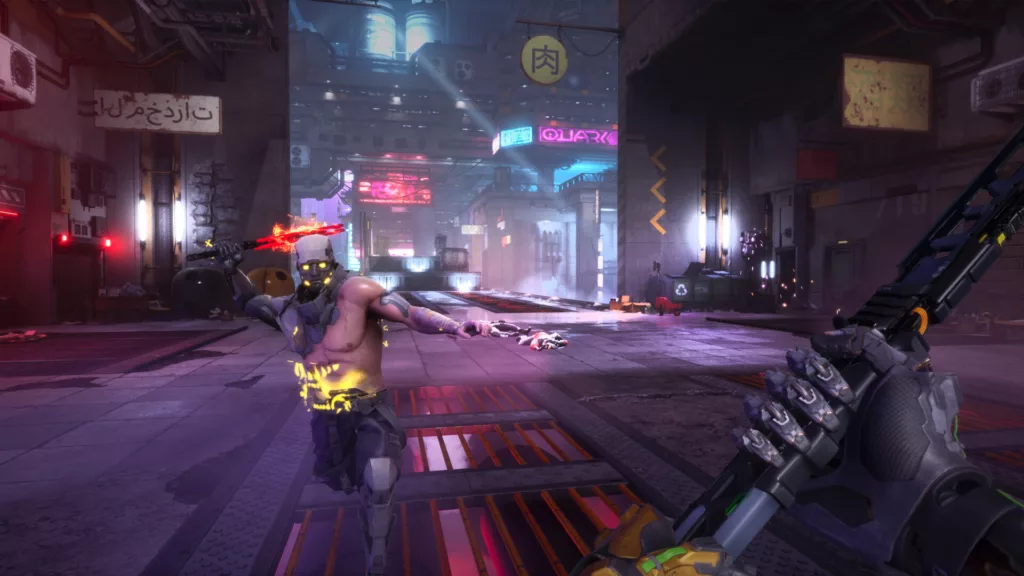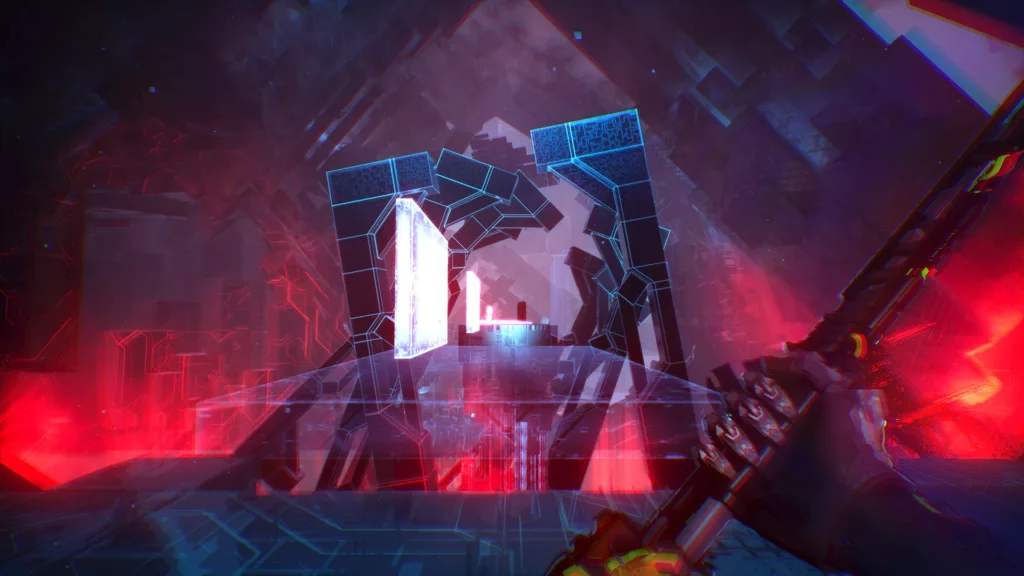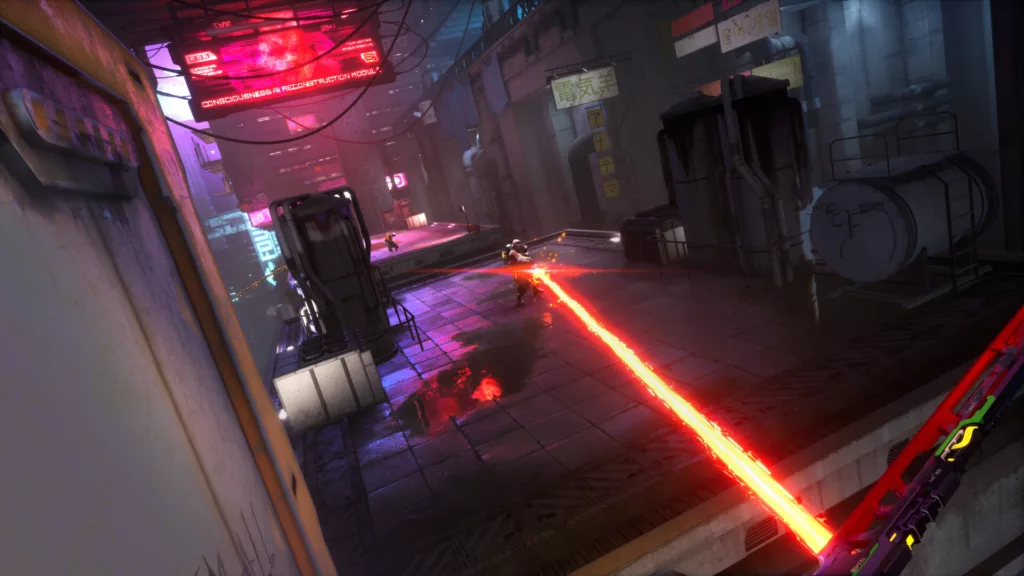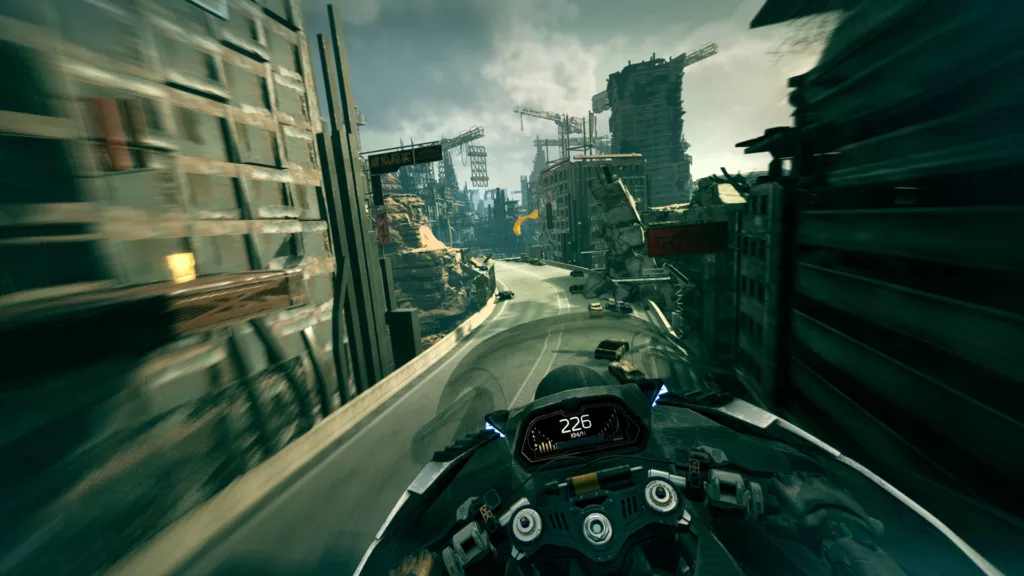Ghostrunner 2 is the direct sequel to the original, from One More Level and 505 Games, that released at the tail end of 2020. It’s a first person, action packed slasher with parkour, set in a dystopian cyberpunk universe. Things pick up one year after the ending of the first game with the Keymaster dead. The new target is a rouge AI cult who are set on upending humanity and the sanctuary of Dharma. It’s a very similar set up to the first game, just with a new antagonist, but the delivery (as well as everything else) has been massively reworked.
The game opens with a bang and throws you right into the heat of the action. The first level plays like a tutorial for newcomers and helps blow the cobwebs off for returning players. You’ll be put through your paces as you wall run, grind and swing through the beautifully presented neon cityscape, hacking enemies to pieces along the way. Radio communications convey a sense of urgency as you hunt down this newly emerged threat. In what seems to be a new tradition for modern, challenging games, you finally engage the games first boss, a snappy skill check to ensure you have understood the basic mechanics. With that chap put to sleep, we meet our first ally in person and are whisked away to HQ.

That’s right, this time, you’ll get the chance to speak to actual people! Sure, you can still expect exposition dumps during gameplay, but now there is a hub where you can chat with your team during downtime. Here we get to learn about each of their roles, get a bit of background on the interpersonal relationships and receive briefings for your next sortie. It’s a sea of calm compared to the main meat of the campaign and it’s worthwhile talking to everyone when you visit.
Missions once again begin in Dharma. A sprawling megacity, full of dark streets and brightly lit neon signs. Steam billows from vents, and metal gantries streak across the skyline creating a vast, yet claustrophobic environment. Parkour playgrounds with hidden collectibles encouraging exploration. You can also expect the usual jump pads, conveniently placed shipping containers and crane arms to aid your traversal. Every area is much more open and what joy it is.

What we have here is almost perfectly integrated fast, flowing movement with precision combat. The feeling the game elicits when you chain everything together into a beautiful ballet of blood and parkour is like a drug. Sliding down a girder, launching yourself into the void and using the grappling hook to swing towards a distant wall. Expertly executing a wall run that transitions into a rail grind, before being scooped into the air by a jump pad. All the while, deflecting bullets, slipping under laser beams, lobbing shuriken at explosive barrels and lopping limbs off bad guys with your cyber katana. It’s the ultimate power fantasy when everything chains together smoothly, and it left me grinning and whooping like a loon. I definitely swore in amazement. It’s still one hit kills though, so you are constantly teetering on the edge of death and your next swear word.
There are a bounty of skills to be unlocked and upgraded to help you along the way. As well as the aforementioned shuriken, we have Tempest which is a gust of wind that launches enemies into the air, which can then be used as grapple points to get into combat quickly. Shadow which creates a duplicate that distracts enemies and makes you invisible. Each of the skills can be upgraded via the cyberdeck – a tool to install ‘mods’ and enhancements. These often reduce energy costs, but also make weaponry more deadly. This itself becomes a balancing act as you pick your preferred boons while trying to stay within limited energy availability. There’s also a bunch of supers to help give you the edge such as a blink teleport, a laser beam, bullet time and more.

Bosses have also been reworked to feel more like puzzles. One guy sees you swinging and sliding around clearing totems and mobs, while another, sees you driving through the belly of a beast avoiding obstacles. The fights are fun, challenging and expect you to employ all you have learned. It’s a great feeling figuring out all the tells and using the environment and skills to your advantage. Whether its avoiding aerial bombardments or simply wall running and then launching into a barrage of katana attacks, these encounters felt rewarding once you’d overcome them.
If this was all the game offered, it would still be a great follow up purely due to the core gameplay mechanics being solid. But there’s a whole new world out there to explore. At a certain point in the story you find an old motorbike and everything is flipped on its head. You begin by chasing a signal through the vents and lost areas of Dharma, jet boosting over gaps, driving on the ceiling and avoiding giant fans until you slide under a closing doorway and into the expanse. As your eyes adjust to the bright sunlight, a sprawling city comes into view and this is when the game truly opens up. The next few hours are spent exploring a dusty, ruined city. Roads crumble and fall, creating perfect jumps. Abandoned vehicles and rusted metal work imbue the sense that it’s been a long time since anyone has seen the outside world. Thankfully, these sections are incredibly fun and tie into the parkour gameplay perfectly. It’s exceptionally satisfying to hit top speed, bank round a tight corner by wall-riding, ejecting from the bike into the air to avoid a laser wall and then using the grappling hook to pull yourself back onto the bike before you clear a huge gap. Once again, the feeling of flow makes you feel like the cyborg future ninja you always wanted to be. In fact this is the whole game in a nutshell. It might put you down a few times as you figure out its intricate clockwork arena, but once you make everything work and stop falling over your own fingers it feels glorious.

All of this is enhanced by the thumping soundtrack and stellar presentation. The synth soundtrack is perfect for the setting and when it ramps up during combat, it adds excitement and tension. It also compliments the visuals, which have been enhanced since the original. A heavy industrial vibe consisting of grey concrete walls and grates, all bathed in a rich neon hue. The cybervoid is bright and open, with islands of land, snaking grind rails and plenty of platforming. The desolate outside world, caked in sand and decades of decay. It really is a beautiful place to explore that oozes cool and swagger.
If it wasn’t clear from my impressions, I loved my time with Ghostrunner 2. There’s such a wealth of content here between the campaign and the Roguerunner mini game. The puzzle like environments, challenging gameplay and gorgeous presentation sell the vision perfectly. I did have occasional framerate hiccups, a weird menu bug and the occasional traversal issues, but none of this has enough impact to detract from what is a stellar title. Once you get your fingers untwisted and the game starts throwing everything at you, it gets better and better.
Overall
-
CX Score - 95%95%
Summary
Pros
- Presentation
- Parkour is smooth
- Puzzles
- Challenge is just right
Cons
- Occasional menu bugs
- Framerate drops very, very occasionally
- Platforming can get demanding

